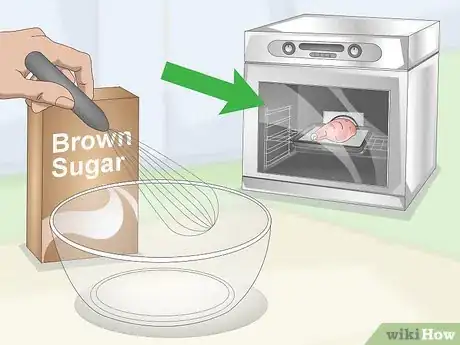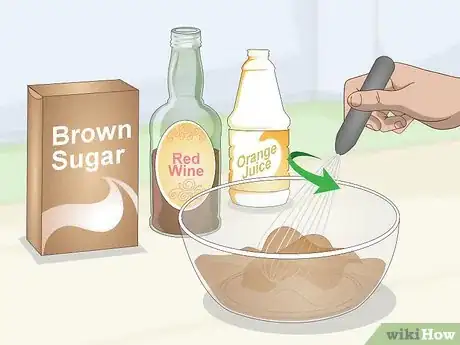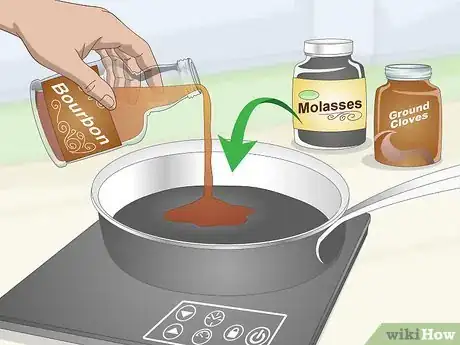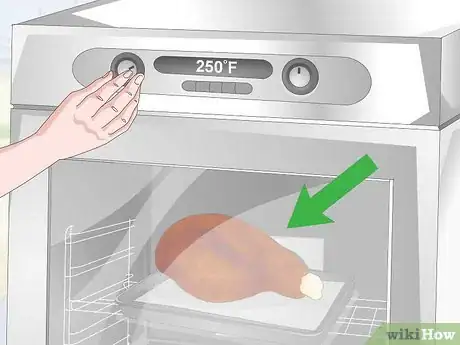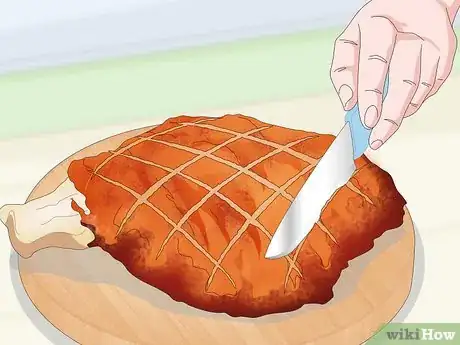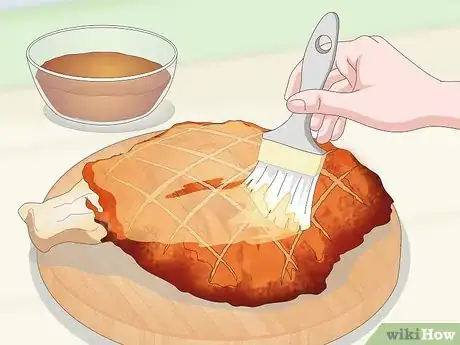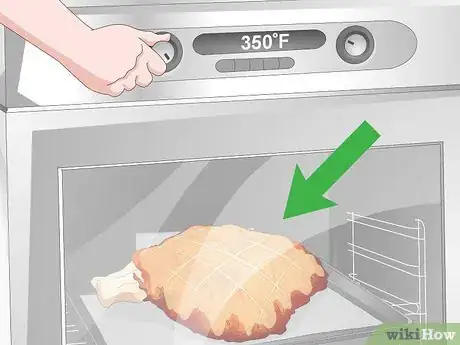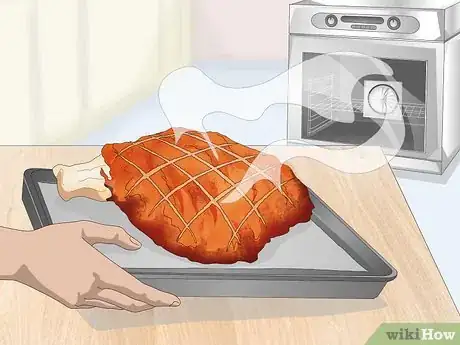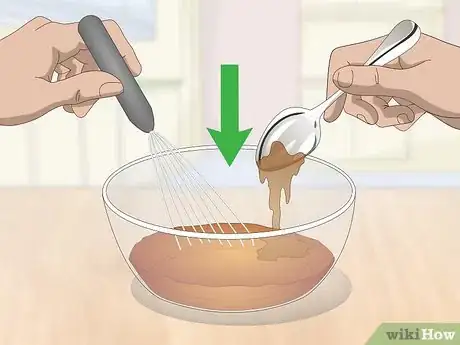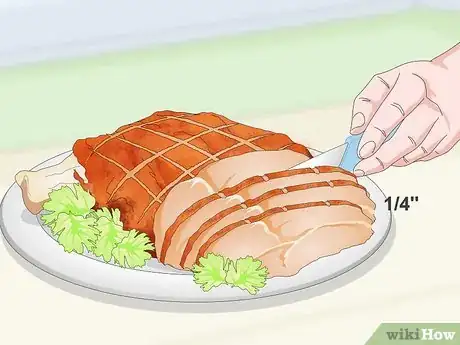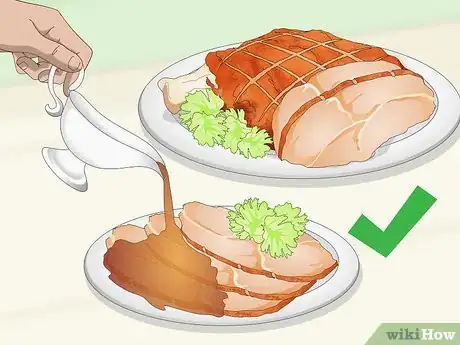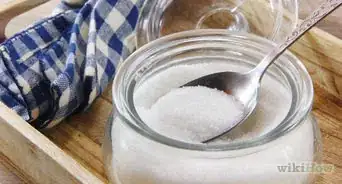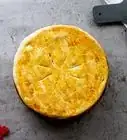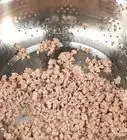This article was co-authored by Sasha Reyes. Chef Sasha Reyes is the Executive Chef and Owner of Artisan Personal Chefs. With over 20 years of food industry experience, she specializes in private dinner parties, custom sports nutrition plans for professional athletes, and cooking lessons. Chef Reyes graduated from Arizona Culinary Institute in 2011 with a degree in Culinary Arts, Baking, and Restaurant Management.
There are 9 references cited in this article, which can be found at the bottom of the page.
This article has been viewed 176,823 times.
A glazed ham is an impressive main course for any festive occasion. It’s easy to make, and a few tricks can guarantee moist, tender meat and a flavorful, gleaming glaze. Prepare the glaze while the ham’s in the oven, and brush it on when the ham is nearly done. Continue to bake the ham for around 15 minutes, or until the glaze is crispy and caramelized. For best results, use a meat thermometer to track the internal temperature and cook your ham to perfection.
Ingredients
Simple Brown Sugar Glaze
- 1 ⅓ cup (265 g) dark brown sugar
- 1⁄4 cup (59 mL) orange juice, red wine, or cognac
Brown Sugar and Soy Sauce Glaze
- 1 ⅓ cup (265 g) light brown sugar
- 2⁄3 cup (160 mL) soy sauce
- 2 garlic cloves, minced
Bourbon, Molasses, and Clove Glaze
- 1 1⁄3 cups (320 mL) molasses
- 2⁄3 cup (160 mL) bourbon
- ½ teaspoon (1 g) ground cloves
Maple-Orange Glaze
- 3⁄4 cup (180 mL) maple syrup
- 1⁄2 cup (120 mL) orange marmalade
- 2 tablespoons (30 g) unsalted butter
- 1 tablespoon (16 g) Dijon mustard
- 1 teaspoon (2 g) ground black pepper
- ¼ teaspoon (¾ g) ground cinnamon
Steps
Making a Glaze
-
1Prepare the glaze after putting the ham in the oven. Eventually, you’ll glaze the ham about 15 to 20 minutes before it’s finished cooking. To have the glaze ready in time, start working on it around 45 to 60 minutes before you expect the ham to be done.[1]
- Quick glazes take mere minutes, and even those that need to be reduced on the stove top take under 15 minutes.
-
2Whisk up a brown sugar glaze if you want a simple, classic option. For the easiest, no-cook option, simply whisk together 1 ⅓ cup (265 g) of dark brown sugar with 1⁄4 cup (59 mL) of orange juice, red wine, or cognac. Mix the ingredients in a small bowl until the sugar has dissolved completely.[2]Advertisement
-
3Simmer a soy sauce glaze to add savory notes. Alternatively, combine 1 ⅓ cup (265 g) of light brown sugar, 2⁄3 cup (160 mL) of soy sauce, and 2 minced garlic cloves in a small saucepan, then bring the ingredients to a boil over medium heat.[3]
- Lower the heat once the mixture has reached a boil. Stir it occasionally, and simmer it for 3 to 5 minutes, or until it’s thickened slightly. Then turn off the heat, and allow the glaze to cool for at least 10 to 15 minutes before brushing it over the ham.
-
4Combine bourbon, molasses, and cloves for a deep, warm glaze. Whisk together 1 1⁄3 cups (320 mL) of molasses, 2⁄3 cup (160 mL) of bourbon, and ½ teaspoon (1 g) of ground cloves in a small saucepan. Bring the ingredients to a boil over medium heat, then reduce the heat and simmer, stirring occasionally, for 3 to 5 minutes.[4]
- Once the mixture has thickened slightly, turn off the heat, and let it cool for 10 to 15 minutes.
-
5Make a maple-orange glaze for a tangy, bright flavor combination. Combine 3⁄4 cup (180 mL) of maple syrup, 1⁄2 cup (120 mL) of orange marmalade, 2 tablespoons (30 g) of unsalted butter, 1 tablespoon (16 g) of Dijon mustard, 1 teaspoon (2 g) of ground black pepper, and ¼ teaspoon (¾ g) of ground cinnamon in a small saucepan. Simmer the mixture over medium heat, stirring occasionally, for 5 to 10 minutes, or until it’s syrupy and has reduced to 1 cup (240 mL).[5]
- Let the glaze cool for at least 10 to 15 minutes before brushing it over the ham.
Tip: If you don’t have orange marmalade handy, substitute it with the zest and unstrained juice of 2 oranges combined with 1⁄4 cup (59 mL) of honey.[6]
-
6Try coming up with your own custom glaze. You can find countless recipes for glazes, but coming up with your own glaze is easy. Experiment with ingredients on hand until you've balanced sweet, acidic, and savory flavors. Aim to make between 1 and 2 cups (240 and 470 mL) of glaze, and reserve about a third of it to serve at the dinner table.[7]
- The basic ingredients of a glaze are a sweetener (such as brown sugar or molasses), an acid (such as vinegar or orange juice), and herbs or spices (such as thyme or cloves).
Applying the Glaze
-
1Bake a cured or pre-cooked ham covered at 250 °F (121 °C). Preheat the oven, remove the ham from its package, and pat it dry. Place the ham in an oven bag, and set it cut-side down on a shallow roasting pan lined with aluminum foil. If you don’t have an oven bag, cover the ham loosely with aluminum foil.[8]
- Plan on baking a cured (pre-cooked) ham for about 10 to 15 minutes per pound (about 22 to 33 minutes per kg), or until it reaches an internal temperature of 110 °F (43 °C). If you didn’t soak the ham to bring it to room temperature, plan on heating it for an hour longer.
Variation: If you’re baking an uncooked ham, preheat your oven to 325 °F (163 °C). Set the ham in a foil-lined roasting pan, and pour 1⁄2 cup (120 mL) of bourbon, cider, wine, or water over it. Bake it for about 20 minutes per pound (about 44 minutes per kg), or until it reaches an internal temperature of 150 °F (66 °C).[9]
-
2Remove the ham from the oven 20 minutes before it's finished baking. If you’re reheating a cured ham, take it out of the oven once it reaches an internal temperature of 110 °F (43 °C). For a 7 to 10 pounds (3.2 to 4.5 kg) ham soaked in hot water and baked at 250 °F (121 °C), that should take about 1 to 1 ½ hours.[10]
- Rest the hot roasting pan on a wire cooling rack. After you take out the ham, raise the oven temperature to 350 °F (177 °C).
- If you’re cooking an uncured ham at 325 °F (163 °C), take it out of the oven once it’s reached an internal temperature between 135 to 140 °F (57 to 60 °C), or after about 2 hours.[11]
-
3Score the ham if it’s not spiral-sliced. Make a series of 1⁄2 inch (1.3 cm) deep diagonal cuts 1 inch (2.5 cm) apart across the top surface of the ham. Then rotate the pan and make diagonal cuts in the other direction to make a grid of diamond shapes. Scoring makes for a great presentation and allows the glaze to penetrate deeper into the meat.[12]
- Scoring the ham before applying a glaze will also help the ham absorb flavors better.
- Since a spiral-sliced ham is pre-cut, scoring is unnecessary.
- If desired, press a whole clove into each point where 2 scored lines intersect. Just remember to remove them before you carve and serve the ham.
Optional: Prior to scoring and glazing, some cooks prefer to remove the rind, or the skin, and top layer of fat. If you’d like, slice and peel them off with a sharp knife. Then score the ham by making 1⁄4 inch (0.64 cm) deep cuts across the its surface.[13]
-
4Brush the ham with about a third of the glaze. Use a basting brush or a spoon to coat the ham with a portion of the glaze. Be sure to work the glaze into the ham’s scored lines or spiral cuts.[14]
- The sugars in the glaze will caramelize, yielding an attractive, flavorful, and candy-like skin. Glazing the ham too early in the cooking process will lead to a scorched ham, so wait until the last 15 to 20 minutes.
-
5Raise the oven to 350 °F (177 °C) and continue baking the ham. Return the ham to the oven and continue baking it, uncovered, until the glaze begins to become shiny, crispy, and slightly brown.[15]
- Raise the temperature when you first remove the ham so the oven has time to heat.
-
6Brush on another third of the glaze after about 10 minutes. Work quickly when you brush on more glaze to prevent the oven temperature from dropping too low. Keep the ham in the oven for another 5 to 10 minutes until the surface is crisp, brown, and caramelized.[16]
- Be sure to keep a close eye on the ham through the oven window to keep it from burning.
Serving Your Glazed Ham
-
1Remove the ham from the oven and let it rest. Take the ham out of the oven, transfer it to a carving board, and turn off the oven. Tent it loosely with foil, and let it rest for 15 to 20 minutes.[17]
- While the ham rests, its internal temperature will increase a bit. This means the final serving temperature will be around 120 °F (49 °C) for a cured ham and 145 to 150 °F (63 to 66 °C) for one that was uncooked when you purchased it.
- For a fresh, uncooked ham, 145 °F (63 °C) is the recommended safe internal temperature. A cured ham was already cooked, so it’s even safe to eat cold.[18]
-
2Make a quick sauce with the rest of the glaze. While the ham rests, whisk 2 to 4 tablespoons of the pan juices with the remaining third of the glaze until you’ve thinned it into a sauce.[19]
- To keep the glaze warm, place the saucepan over a burner set to low heat and stir it occasionally.
-
3Present the ham to your guests before carve it. Garnish the ham with a bouquet of fresh herbs, such as parsley or watercress, and show it off to your guests. Once they've had a chance to admire your handiwork, you can get to carving and serving the ham.[20]
-
4Carve the ham into 1⁄4 inch (0.64 cm) slices. If your ham isn’t pre-cut, slice it yourself with a sharp carving or chef’s knife. First, remove the cloves, if you inserted any into the scored surface. Cut off a few slices to flatten the thinner side, then turn the ham onto the flat side so it won’t roll as you carve the meatier side.[21]
- If you look at the cut side, you’ll see that the bone is closer to one edge. This is the thinner side, and you want to carve the opposite, meatier side.
- Slice straight down into the ham until you reach the bone. Make cuts every 1⁄4 inch (0.64 cm), then run the knife horizontally along the bone to remove the slices.
- If you bought a spiral-sliced ham, simply cut along the bone to remove the slices.
-
5Serve the ham slices with your glaze sauce. Transfer the slices, along with your garnishes, to a serving platter. Set a serving fork on the platter, and pour the glaze sauce into a gravy boat. Bring the boat and platter to the table, serve your guests, and invite them to add sauce to their liking.[22]
- Pair your glazed ham with side dishes such as balsamic green beans, mashed or scalloped potatoes, and roasted carrots.
Expert Q&A
-
QuestionHow do you score a ham roast?
 Sasha ReyesChef Sasha Reyes is the Executive Chef and Owner of Artisan Personal Chefs. With over 20 years of food industry experience, she specializes in private dinner parties, custom sports nutrition plans for professional athletes, and cooking lessons. Chef Reyes graduated from Arizona Culinary Institute in 2011 with a degree in Culinary Arts, Baking, and Restaurant Management.
Sasha ReyesChef Sasha Reyes is the Executive Chef and Owner of Artisan Personal Chefs. With over 20 years of food industry experience, she specializes in private dinner parties, custom sports nutrition plans for professional athletes, and cooking lessons. Chef Reyes graduated from Arizona Culinary Institute in 2011 with a degree in Culinary Arts, Baking, and Restaurant Management.
Executive Chef The blowtorch method works well! Prepare your glaze and use a small kitchen blowtorch along the exterior of them ham—this helps you get a crispy, crunchy, and candied exterior.
The blowtorch method works well! Prepare your glaze and use a small kitchen blowtorch along the exterior of them ham—this helps you get a crispy, crunchy, and candied exterior. -
QuestionAt what temperature should I take my bone-in ham out and put the glaze on?
 Community AnswerI make a glaze of brown sugar, pineapple juice and dry mustard and put it on the ham, along with clove spears and pineapple rings, put it in the oven at 275 and let it slow bake about 10 hrs, then up the temp to 350 for one hour before carving. Baste frequently while baking. Put a little water in the bottom of the roaster while baking to keep it from drying out.
Community AnswerI make a glaze of brown sugar, pineapple juice and dry mustard and put it on the ham, along with clove spears and pineapple rings, put it in the oven at 275 and let it slow bake about 10 hrs, then up the temp to 350 for one hour before carving. Baste frequently while baking. Put a little water in the bottom of the roaster while baking to keep it from drying out. -
QuestionDo I cover the ham while baking?
 Community AnswerCover with foil for 3/4 of the baking time, then uncover to crisp the rind up. It needs to be scored in order to crisp.
Community AnswerCover with foil for 3/4 of the baking time, then uncover to crisp the rind up. It needs to be scored in order to crisp.
Things You'll Need
- Roasting pan
- Oven bag (or aluminum foil)
- Meat thermometer
- Small saucepan
- Measuring cup
- Measuring spoon
- Whisk
- Basting brush or spoon
- Cutting board
- Chef's knife
References
- ↑ https://www.marthastewart.com/268082/ham-101
- ↑ https://www.marthastewart.com/314339/baked-easter-ham
- ↑ https://www.thekitchn.com/five-3-ingredient-glazes-for-a-whole-ham-tips-from-the-kitchn-217372
- ↑ https://www.thekitchn.com/five-3-ingredient-glazes-for-a-whole-ham-tips-from-the-kitchn-217372
- ↑ https://www.cooksillustrated.com/recipes/3906-glazed-spiral-sliced-ham
- ↑ https://www.thekitchn.com/five-3-ingredient-glazes-for-a-whole-ham-tips-from-the-kitchn-217372
- ↑ https://www.thekitchn.com/five-3-ingredient-glazes-for-a-whole-ham-tips-from-the-kitchn-217372
- ↑ https://www.cooksillustrated.com/articles/196-holiday-ham-101
- ↑ https://www.marthastewart.com/268082/ham-101
- ↑ https://www.cooksillustrated.com/recipes/3906-glazed-spiral-sliced-ham
- ↑ https://www.marthastewart.com/268082/ham-101
- ↑ https://www.bhg.com/recipes/how-to/cooking-basics/how-to-glaze-ham/
- ↑ https://www.marthastewart.com/268082/ham-101
- ↑ https://www.cooksillustrated.com/recipes/3906-glazed-spiral-sliced-ham
- ↑ https://www.cooksillustrated.com/articles/196-holiday-ham-101
- ↑ https://www.thekitchn.com/5-mistakes-to-avoid-when-baking-a-whole-ham-tips-from-the-kitchn-217520
- ↑ https://www.cooksillustrated.com/recipes/3906-glazed-spiral-sliced-ham
- ↑ https://www.fsis.usda.gov/wps/portal/fsis/topics/food-safety-education/get-answers/food-safety-fact-sheets/meat-preparation/ham-and-food-safety/CT_Index
- ↑ https://www.cooksillustrated.com/recipes/3906-glazed-spiral-sliced-ham
- ↑ https://www.marthastewart.com/268082/ham-101
- ↑ https://www.marthastewart.com/268082/ham-101
- ↑ https://www.marthastewart.com/268082/ham-101
- ↑ https://www.cooksillustrated.com/articles/196-holiday-ham-101
- ↑ https://www.cooksillustrated.com/recipes/3906-glazed-spiral-sliced-ham
- ↑ https://www.bonappetit.com/test-kitchen/common-mistakes/article/avoid-these-6-common-mistakes-with-your-easter-ham
About This Article
To glaze a ham, first make your own glaze by mixing dark brown sugar with orange juice, red wine, or cognac. You can also simmer brown sugar, soy sauce, and minced garlic to make a savory glaze. If you'd prefer a bright and tangy glaze, combine maple syrup, orange marmalade, butter, Dijon mustard, black pepper, and cinnamon, and simmer the mixture until it thickens. To apply your glaze, brush it onto the meat both 20 minutes and 10 minutes before it's finished roasting in the oven. To learn how to come up with your own ham glaze recipe, scroll down!
